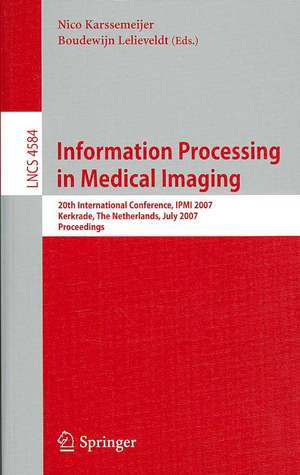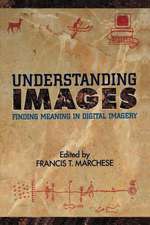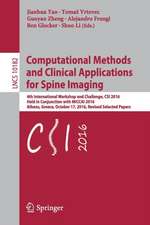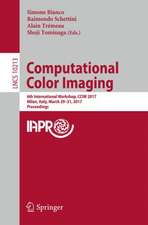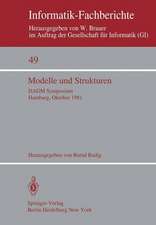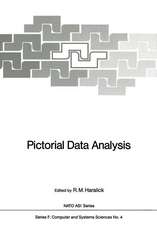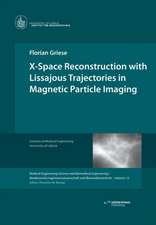Information Processing in Medical Imaging: 20th International Conference, IPMI 2007, Kerkrade, The Netherlands, July 2-6, 2007, Proceedings: Lecture Notes in Computer Science, cartea 4584
Editat de Nico Karssemeijer, Boudewijn Lelieveldten Limba Engleză Paperback – 22 iun 2007
Din seria Lecture Notes in Computer Science
- 20%
 Preț: 1061.55 lei
Preț: 1061.55 lei - 20%
 Preț: 307.71 lei
Preț: 307.71 lei - 20%
 Preț: 438.69 lei
Preț: 438.69 lei - 20%
 Preț: 579.30 lei
Preț: 579.30 lei -
 Preț: 410.88 lei
Preț: 410.88 lei - 17%
 Preț: 427.22 lei
Preț: 427.22 lei - 20%
 Preț: 596.46 lei
Preț: 596.46 lei - 15%
 Preț: 448.04 lei
Preț: 448.04 lei - 20%
 Preț: 353.50 lei
Preț: 353.50 lei -
 Preț: 389.49 lei
Preț: 389.49 lei - 20%
 Preț: 309.90 lei
Preț: 309.90 lei - 20%
 Preț: 645.28 lei
Preț: 645.28 lei - 20%
 Preț: 763.23 lei
Preț: 763.23 lei - 15%
 Preț: 580.46 lei
Preț: 580.46 lei - 20%
 Preț: 310.28 lei
Preț: 310.28 lei - 20%
 Preț: 655.02 lei
Preț: 655.02 lei - 20%
 Preț: 1183.14 lei
Preț: 1183.14 lei - 20%
 Preț: 340.32 lei
Preț: 340.32 lei -
 Preț: 449.57 lei
Preț: 449.57 lei - 20%
 Preț: 591.51 lei
Preț: 591.51 lei - 18%
 Preț: 938.83 lei
Preț: 938.83 lei - 20%
 Preț: 337.00 lei
Preț: 337.00 lei - 20%
 Preț: 649.50 lei
Preț: 649.50 lei - 20%
 Preț: 607.40 lei
Preț: 607.40 lei - 20%
 Preț: 1414.79 lei
Preț: 1414.79 lei - 20%
 Preț: 1024.44 lei
Preț: 1024.44 lei - 20%
 Preț: 583.40 lei
Preț: 583.40 lei - 20%
 Preț: 453.32 lei
Preț: 453.32 lei - 20%
 Preț: 575.49 lei
Preț: 575.49 lei - 20%
 Preț: 1075.26 lei
Preț: 1075.26 lei - 20%
 Preț: 585.88 lei
Preț: 585.88 lei - 20%
 Preț: 825.93 lei
Preț: 825.93 lei - 17%
 Preț: 360.20 lei
Preț: 360.20 lei - 20%
 Preț: 763.23 lei
Preț: 763.23 lei - 20%
 Preț: 340.32 lei
Preț: 340.32 lei - 20%
 Preț: 504.58 lei
Preț: 504.58 lei - 20%
 Preț: 369.13 lei
Preț: 369.13 lei - 20%
 Preț: 580.93 lei
Preț: 580.93 lei - 20%
 Preț: 343.62 lei
Preț: 343.62 lei - 20%
 Preț: 350.21 lei
Preț: 350.21 lei - 20%
 Preț: 583.40 lei
Preț: 583.40 lei - 20%
 Preț: 583.40 lei
Preț: 583.40 lei - 15%
 Preț: 438.59 lei
Preț: 438.59 lei - 20%
 Preț: 341.95 lei
Preț: 341.95 lei - 20%
 Preț: 238.01 lei
Preț: 238.01 lei - 20%
 Preț: 538.30 lei
Preț: 538.30 lei
Preț: 669.56 lei
Preț vechi: 836.96 lei
-20% Nou
Puncte Express: 1004
Preț estimativ în valută:
128.14€ • 133.28$ • 105.78£
128.14€ • 133.28$ • 105.78£
Carte tipărită la comandă
Livrare economică 14-28 aprilie
Preluare comenzi: 021 569.72.76
Specificații
ISBN-13: 9783540732723
ISBN-10: 3540732721
Pagini: 802
Ilustrații: XX, 780 p.
Dimensiuni: 155 x 235 x 32 mm
Greutate: 1.08 kg
Ediția:2007
Editura: Springer Berlin, Heidelberg
Colecția Springer
Seriile Lecture Notes in Computer Science, Image Processing, Computer Vision, Pattern Recognition, and Graphics
Locul publicării:Berlin, Heidelberg, Germany
ISBN-10: 3540732721
Pagini: 802
Ilustrații: XX, 780 p.
Dimensiuni: 155 x 235 x 32 mm
Greutate: 1.08 kg
Ediția:2007
Editura: Springer Berlin, Heidelberg
Colecția Springer
Seriile Lecture Notes in Computer Science, Image Processing, Computer Vision, Pattern Recognition, and Graphics
Locul publicării:Berlin, Heidelberg, Germany
Public țintă
ResearchCuprins
Segmentation.- A Shape-Guided Deformable Model with Evolutionary Algorithm Initialization for 3D Soft Tissue Segmentation.- Shape Regression Machine.- Active Mean Fields: Solving the Mean Field Approximation in the Level Set Framework.- Liver Segmentation Using Sparse 3D Prior Models with Optimal Data Support.- Cardiovascular Imaging.- Adaptive Non-rigid Registration of Real Time 3D Ultrasound to Cardiovascular MR Images.- Multi-slice Three-Dimensional Myocardial Strain Tensor Quantification Using zHARP.- Bayesian Tracking of Elongated Structures in 3D Images.- Effective Statistical Edge Integration Using a Flux Maximizing Scheme for Volumetric Vascular Segmentation in MRA.- Detection and Labeling.- Joint Sulci Detection Using Graphical Models and Boosted Priors.- Rao-Blackwellized Marginal Particle Filtering for Multiple Object Tracking in Molecular Bioimaging.- Spine Detection and Labeling Using a Parts-Based Graphical Model.- Lung Nodule Detection Via Bayesian Voxel Labeling.- Poster Session I.- Functional Interactivity in fMRI Using Multiple Seeds’ Correlation Analyses – Novel Methods and Comparisons.- Learning Best Features and Deformation Statistics for Hierarchical Registration of MR Brain Images.- Information-Theoretic Analysis of Brain White Matter Fiber Orientation Distribution Functions.- Segmentation of Sub-cortical Structures by the Graph-Shifts Algorithm.- High-Quality Consistent Meshing of Multi-label Datasets.- Digital Homeomorphisms in Deformable Registration.- Incorporating DTI Data as a Constraint in Deformation Tensor Morphometry Between T1 MR Images.- LV Segmentation Through the Analysis of Radio Frequency Ultrasonic Images.- Chestwall Segmentation in 3D Breast Ultrasound Using a Deformable Volume Model.- Automatic Cortical Segmentation in theDeveloping Brain.- Comparing Pairwise and Simultaneous Joint Registrations of Decorrelating Interval Exams Using Entropic Graphs.- Combining Radiometric and Spatial Structural Information in a New Metric for Minimal Surface Segmentation.- A Fuzzy, Nonparametric Segmentation Framework for DTI and MRI Analysis.- Symmetric Positive 4 th Order Tensors & Their Estimation from Diffusion Weighted MRI.- Atlas-to-Image Non-rigid Registration by Minimization of Conditional Local Entropy.- Shape Modeling and Analysis with Entropy-Based Particle Systems.- A Volumetric Approach to Quantifying Region-to-Region White Matter Connectivity in Diffusion Tensor MRI.- Brain Image Registration Using Cortically Constrained Harmonic Mappings.- Probabilistic Clustering and Quantitative Analysis of White Matter Fiber Tracts.- Multi-fiber Reconstruction from Diffusion MRI Using Mixture of Wisharts and Sparse Deconvolution.- A Hamiltonian Particle Method for Diffeomorphic Image Registration.- Inter and Intra-modal Deformable Registration: Continuous Deformations Meet Efficient Optimal Linear Programming.- Tracer Kinetics Guided Dynamic PET Reconstruction.- Maximum Likelihood Estimators in Magnetic Resonance Imaging.- Quantifying Metabolic Asymmetry Modulo Structure in Alzheimer’s Disease.- Adaptive Time-Frequency Models for Single-Trial M/EEG Analysis.- Imaging Brain Activation Streams from Optical Flow Computation on 2-Riemannian Manifolds.- High Level Group Analysis of FMRI Data Based on Dirichlet Process Mixture Models.- Poster Session II.- Insight into Efficient Image Registration Techniques and the Demons Algorithm.- Divergence-Based Framework for Diffusion Tensor Clustering, Interpolation, and Regularization.- Localized Components Analysis.- Regional Appearance in Deformable ModelSegmentation.- Fully Automated Registration of First-Pass Myocardial Perfusion MRI Using Independent Component Analysis.- Octree Grid Topology Preserving Geometric Deformable Model for Three-Dimensional Medical Image Segmentation.- High-Dimensional Entropy Estimation for Finite Accuracy Data: R-NN Entropy Estimator.- Kernel-Based Manifold Learning for Statistical Analysis of Diffusion Tensor Images.- An Anatomical Equivalence Class Based Joint Transformation-Residual Descriptor for Morphological Analysis.- Incorporation of Regional Information in Optimal 3-D Graph Search with Application for Intraretinal Layer Segmentation of Optical Coherence Tomography Images.- Localized Maximum Entropy Shape Modelling.- Computer Aided Detection of Pulmonary Embolism with Tobogganing and Mutiple Instance Classification in CT Pulmonary Angiography.- Measures for Pathway Analysis in Brain White Matter Using Diffusion Tensor Images.- Estimating the Mesorectal Fascia in MRI.- A Marginalized MAP Approach and EM Optimization for Pair-Wise Registration.- Geometry Driven Volumetric Registration.- A Recursive Anisotropic Fast Marching Approach to Reaction Diffusion Equation: Application to Tumor Growth Modeling.- Population-Based Fitting of Medial Shape Models with Correspondence Optimization.- Robust Parametric Modeling Approach Based on Domain Knowledge for Computer Aided Detection of Vertebrae Column Metastases in MRI.- Nonrigid Image Registration Using Conditional Mutual Information.- Non-parametric Surface-Based Regularisation for Building Statistical Shape Models.- Geometrically Proper Models in Statistical Training.- Registration-Derived Estimates of Local Lung Expansion as Surrogates for Regional Ventilation.
